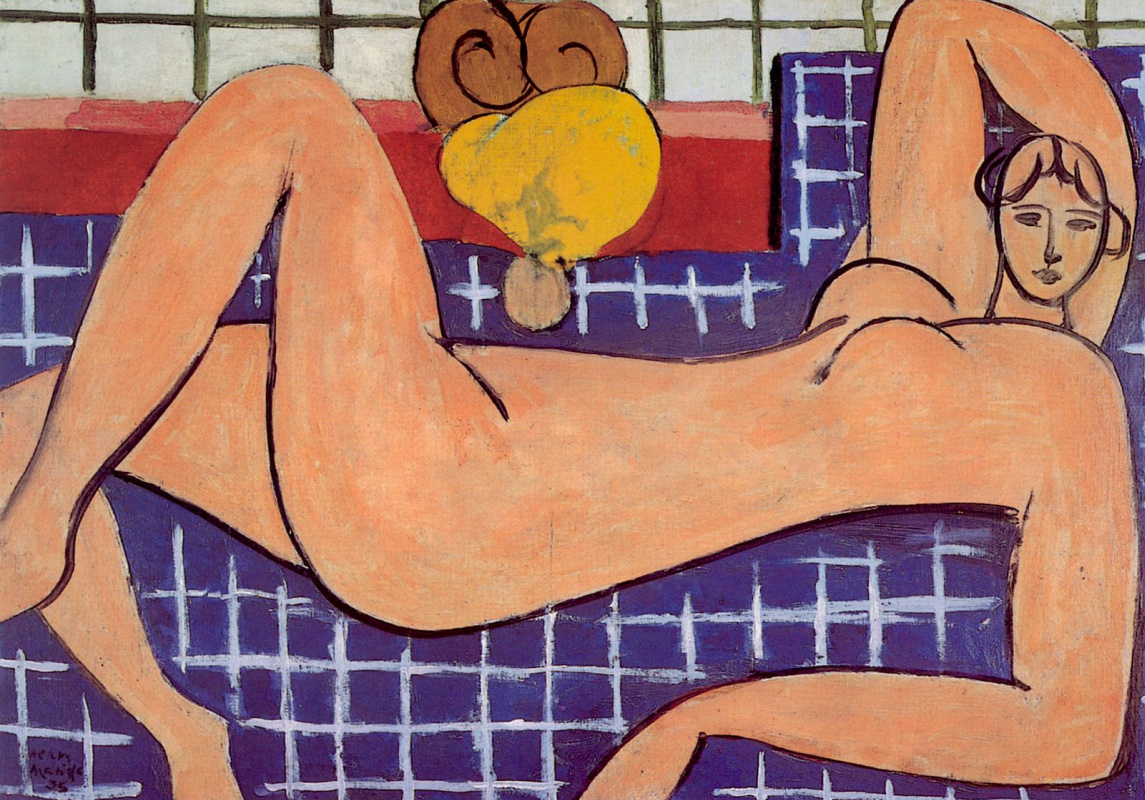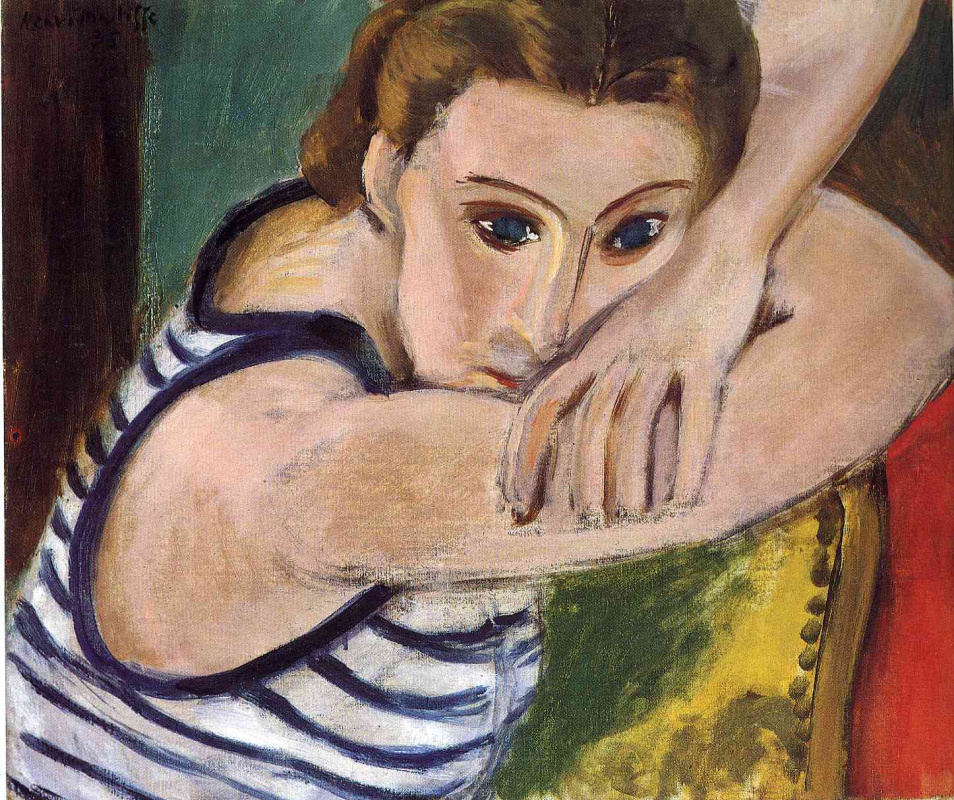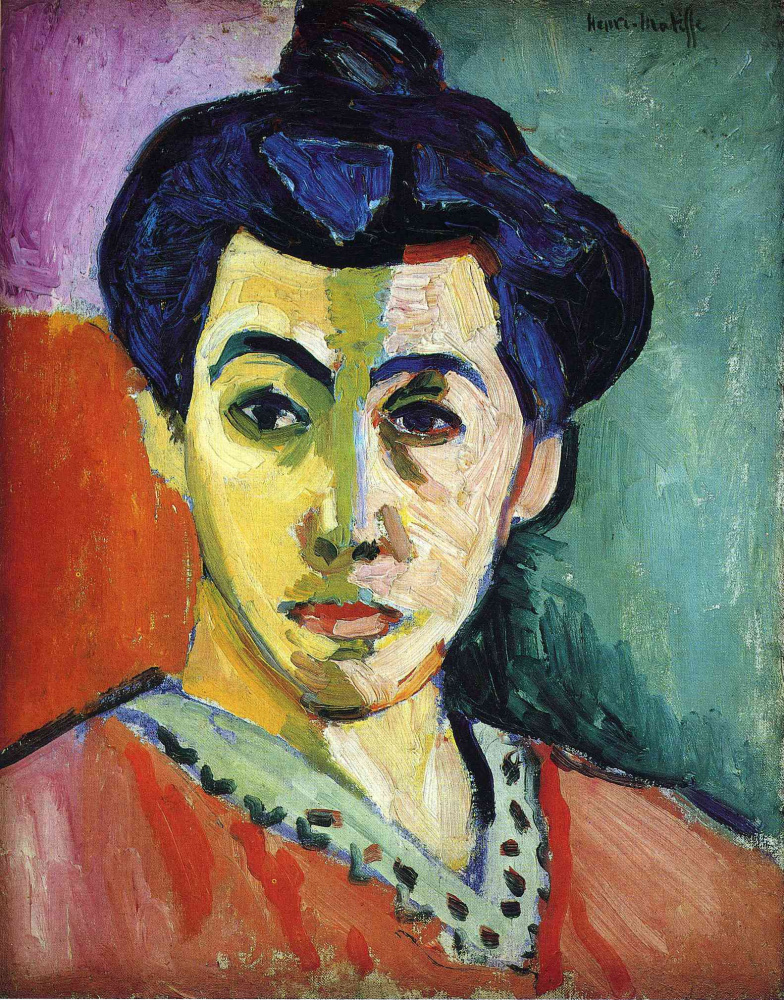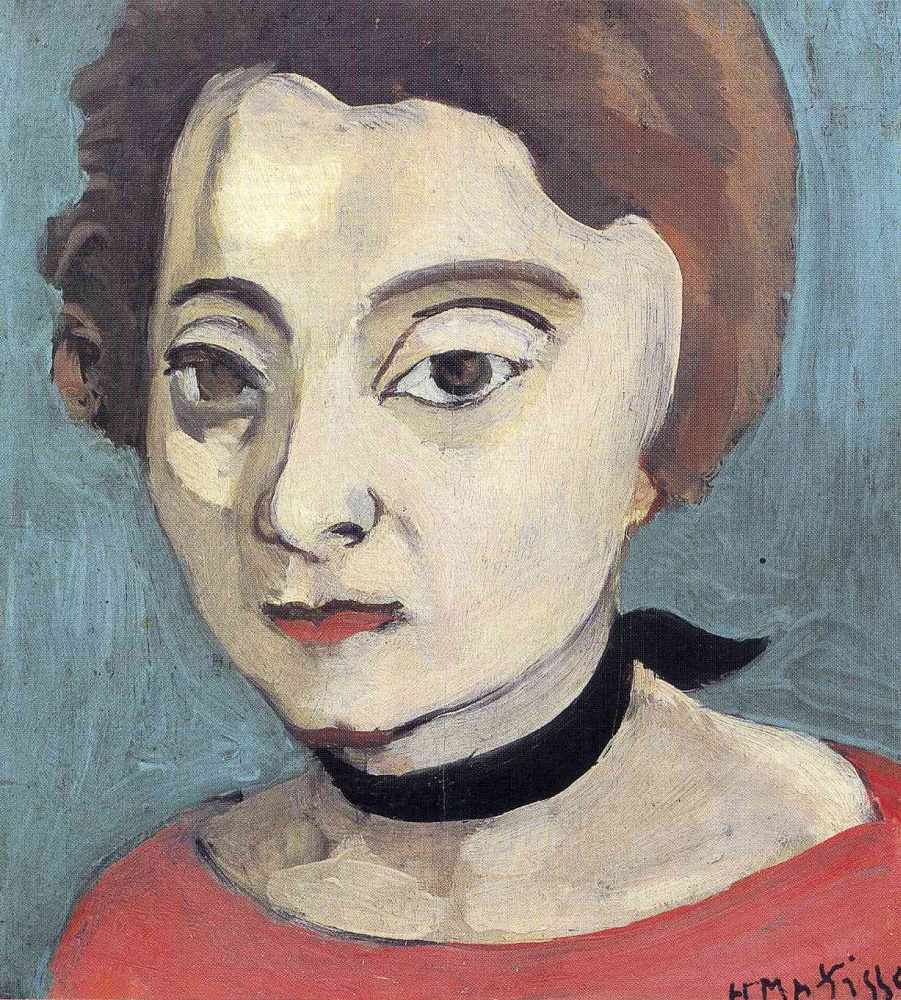Their relationship had no future. A successful French artist of 63 and an unknown Russian emigrant of 22. At the time of their meeting, Matisse was married for 39 years with his faithful Amélie, who raised him two sons and an illegitimate daughter. Although, the artist preferred southern-type models, for the last 22 years of his life, his heart belonged to the blue-eyed and fair-haired "Snow Queen", as he called Délectorskaya.

A model from a nurse
This was not love at first sight. Lydia came to the Matisses in 1932 by announcement: the artist needed an assistant in his workshop. At that time she desperately needed funds, since she left alone in Nice, completely without any means.

Lydia in her favourite position
When Lydia was thirteen, her parents died during an epidemic of typhoid and cholera in Tomsk, where the family lived, and her mother’s sister took the girl to Harbin. There, at the age of 19, she married and left with her husband for Paris, but it soon became clear that they had extremely little in common. After the divorce, she found herself in an unfamiliar country without any friends, money, or command of the language. Therefore, the work with an artist, even if it was meant as temporary, came in handy.
At that time, Matisse worked on the Dance panel commissioned by Albert Barnes. The picture was quite large, and he needed an assistant to cut out figures from coloured paper and move them against a picturesque background, building a composition.
But when Matisse’s wife needed a nurse, Lydia was offered to stay at their house for a longer period. If only Amélie knew what this choice would turn out for her! But at that time she was completely calm about the girl, because she knew her husband liked the dark-haired southerners rather than the Lydia’s type.
Pink nude
1935, 66×920 cm
Indeed, at first Matisse paid no attention to the restrained Slavic beauty of Lydia. Until one day he asked her to freeze and not move: it was the first time he saw something in her that made him immediately grab his brush and begin to paint her portrait. Thus, since 1935, when Lydia began to pose for Matisse almost every day, until the summer of 1939, the artist painted at least 90 paintings, unless numerous drawings and sketches.
Blue eyes
1934, 46×38 cm
Large Reclining Nude
was his first painting of Lydia. And at the Blue Eyes Matisse first captured the girl in her favourite pose with her head on the back of a chair. Working with her, the artist returned to the previously beloved storyline "The Nymph and the Satyr", only that he no longer depicted the scenes of violence in such paintings.

Lydia was so far from art that at first she had no idea who her employer was: "I did not think much about painting before that," she said. "And even the fact that Henri Matisse was an artist of world renown, for many years remained an abstraction for me: I knew it, but I didn’t get it, it didn’t touch me. Matisse saw it, but he did not blame me for this and did not try to teach me. He only supported my interest in his work."
Happy together

In addition to her expressive appearance that attracted Matisse as an artist, Lydia possessed the qualities that gradually made her indispensable for him. Her decency, prudence, organizational skill and accuracy in everything contributed to the fact that all the affairs in the house gradually passed into her jurisdiction: Lydia began to manage both the household and Matisse’s affairs.
Everything went so far that Amélie, the artist’s wife, began to insist that her former nurse leave the house. "Madame wanted me to leave, and not from female jealousy at all, but because I administered all their affairs and took too much space in the house," Lydia recalled. But the artist could no longer do without his Russian assistant, and then Amélie decided that she was the one to leave.
Madame Matisse
1905, 40.5×32.5 cm
In 1939, she initiated the divorce proceedings, and the lawyer of Madame Matisse drew up an act according to which all the property of the spouses, including paintings and drawings, should be divided in half. But the artist could not afford to survive such stress, and the divorce never took place. And Lydia never insisted on it. Despite the fact that she did not feel very comfortable in the unclear status of the artist’s secretary, she could not let him pass through the destructive divorce proceedings. Although Matisse was ready to go for it for her sake: "Madame Lydia, I see how hard it is for you, and if you want, I’m ready to divorce Madame Matisse," he suggested. But he always received her flat refusal.

Lydia posing for Matisse
"You want to know, whether I was Matisse’s ‘wife'. Both no and yes. In the material, physical sense of the word — no, but in the spiritual sense — even more than yes. For 20 years, I was ‘the light for his eyes', and he was the only meaning of my life," wrote Lydia about her relationship with the artist.
Lidia Nikolaevna Delectorskaya
1940, 73.5×108 cm
Délectorskaya was extremely scrupulous in all matters and always took care that no one could reproach her with opportunism or greed. The artist took the habit of presenting his paintings to Lydia twice a year (for her birthday and Christmas), and she made him write receipts confirming the fact of donation, so that in the future no one could assume that she had appropriated them for herself, taking advantage of her position. She even bought some paintings and drawings from Matisse and flatly refused any discount, claiming that she should pay the same price as any other collector.
War and Peace
At the time of hostilities in France in 1939, Matisse was already 70 years old. By coincidence, Lydia was the only one who was next to him in difficult war years, and helped him endure all the hardships. His eldest son, Pierre, lived in the United States, his daughter Marguerite took part in the Resistance, and his wife was taken to prison for typing underground newspapers on a typewriter.
Margarita with black velvet ribbon
1916, 18×17 cm
Matisse had an open visa to Brazil, but he could not leave without Lydia, and therefore remained in France. She answered him with unlimited devotion, showing miraculous endurance. When in 1943, in the front-line Vance, they had difficulties with fuel for heating and provisions, Délectorskaya came up with the experience of survival in Siberia, where she spent her childhood. Lydia heated the stove and curtained the windows with carpets to keep the house warm longer. Once she walked 25 km in the open sun to give an urgent package to the artist’s publisher when there was no transport connection. Matisse made fun of Lydia’s Russian excerpt, saying that he would be surprised if he suddenly found out that she could not fly an airplane.
Odalisque. Blue Harmony
1937, 62×51 cm
At that time, she knew the artist like no other, and helped him cope with his physical ailment. "Since 1942 he had had a night nurse," Lydia told her friend, writer Konstantin Paustovsky. "But when it was too hard for him, he sent her after me. If asthma medications did not help, I sat down by his bed, took his hand and simply, but persistently asked, what ‘back thought' bothered him. He usually denied, but ended up finding some really restless, relentless thought. We ‘bit it through', and I instantly proved to him that it was none of disturbing, and the asthma attack subsided."

In one of the drawings with a portrait of Délectorskaya, Matisse wrote: "To Lydia, who has no wings, but she certainly deserves them. Softness and kindness. As a sign of respect!"
After the liberation of Paris in 1944, Matisse’s relatives returned from prison, but the peace did not reign in the family: the artist’s children intensely disliked his faithful girlfriend. The artist was already very ill (he underwent a complicated operation due to intestinal cancer) and needed her more than ever. "Lydia had neither days off nor free evenings," the family friend recalled. "Matisse constantly talked about her outstanding qualities, hardly endured parting with her, but he knew how to get Lydia crazy."
44 years without Matisse
On the first day of November 1954, the artist was struck by a microstroke, and he was gone on the 3rd of November. Lydia immediately left his house with all her belongings, since she did not claim either his property or a place in his family. She was not invited to the funeral, and Matisse’s grandson said that she was "just a salary woman".
Lydia - hairstyle in the grid
1939, 26×20.2 cm
For the rest of her life, Lydia lived alone, she fully devoted herself to working with the artist’s heritage. She literally saved funds on everything and spent all her savings on the acquisition of Matisse’s works, which she sent to Russia as a gift to the Moscow and St. Petersburg museums. In total, Lydia presented the Pushkin Museum and the Hermitage with more than two hundred paintings, sketches, drawings, books and sculptures by Matisse. She published his works, two huge catalogs of 1,500 pages, and organized a museum in the artist’s homeland in Le Cateau-Cambrésis. She helped to organize Matisse exhibitions, and she became the main specialist in his ouevre. It seemed that Lydia did everything to maintain contact with the artist even after his death.
Portrait of Lydia Delectorskaya
1947, 64.5×49.5 cm
Délectorskaya was friends with Polenov’s grandson, and when he asked if she needed any help, she replied: "When I need some help, I will go to him," and she pointed up to the sky. Apparently, such a day came when Lydia committed suicide at the age of 84. Her last will was a note with the following words: "Please put Henri Matisse’s shirt next to me".
Photo source: moya-planeta.ru

















